Other years |
| Countries of the United Kingdom |
| Scotland |
| Sport |
| 1778 English cricket season |

Events from the year 1778 in Great Britain .
Other years |
| Countries of the United Kingdom |
| Scotland |
| Sport |
| 1778 English cricket season |

Events from the year 1778 in Great Britain .

William Pitt, 1st Earl of Chatham was a British Whig statesman who served as Prime Minister of Great Britain from 1766 to 1768. Historians call him "Chatham" or "Pitt the Elder" to distinguish him from his son William Pitt the Younger, who also served as prime minister. Pitt was also known as "the Great Commoner" because of his long-standing refusal to accept a title until 1766.

William Pitt was a British statesman who served as the last prime minister of Great Britain from 1783 until the Acts of Union 1800, and then first prime minister of the United Kingdom from January 1801. He left office in March 1801, but served as prime minister again from 1804 until his death in 1806. He was also Chancellor of the Exchequer for all of his time as prime minister. He is known as "Pitt the Younger" to distinguish him from his father, William Pitt the Elder, who had also previously served as prime minister.
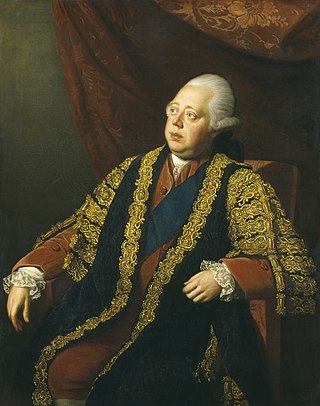
Frederick North, 2nd Earl of Guilford, better known by his courtesy title Lord North, which he used from 1752 to 1790, was Prime Minister of Great Britain from 1770 to 1782. He led Great Britain through most of the American Revolutionary War. He also held a number of other cabinet posts, including Home Secretary and Chancellor of the Exchequer.

Admiral of the Fleet Richard Howe, 1st Earl Howe, was a Royal Navy officer and politician. After serving in the War of the Austrian Succession, he gained a reputation for his role in amphibious operations against the French coast as part of Britain's policy of naval descents during the Seven Years' War. He also took part, as a naval captain, in the decisive British naval victory at the Battle of Quiberon Bay in November 1759.

William Petty Fitzmaurice, 1st Marquess of Lansdowne, known as the Earl of Shelburne between 1761 and 1784, by which title he is generally known to history, was an Anglo-Irish Whig statesman who was the first home secretary in 1782 and then prime minister in 1782–83 during the final months of the American War of Independence. He succeeded in securing peace with America and this feat remains his most notable legacy.

William Alexander, also known as Lord Stirling, was a Scottish-American major general during the American Revolutionary War. He was considered male heir to the Scottish title of Earl of Stirling through Scottish lineage, and he sought the title sometime after 1756. His claim was initially granted by a Scottish court in 1759; however, the House of Lords ultimately overruled Scottish law and denied the title in 1762. He continued to hold himself out as "Lord Stirling" regardless.
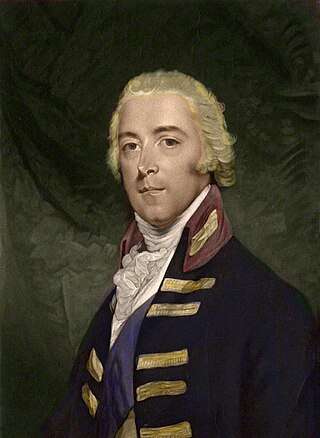
General John Pitt, 2nd Earl of Chatham, was a British soldier and politician. He spent a lengthy period in the cabinet but is best known for commanding the disastrous Walcheren Campaign of 1809.
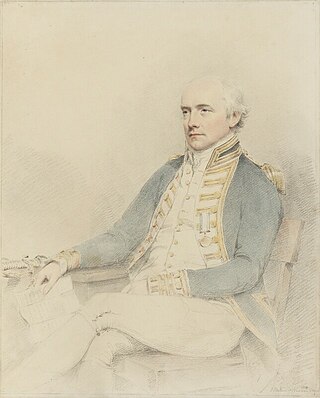
Admiral of the Fleet James Gambier, 1st Baron Gambier, was a Royal Navy officer. After seeing action at the capture of Charleston during the American Revolutionary War, he saw action again, as captain of the third-rate HMS Defence, at the battle of the Glorious First of June in 1794, during the French Revolutionary Wars, gaining the distinction of commanding the first ship to break through the enemy line.
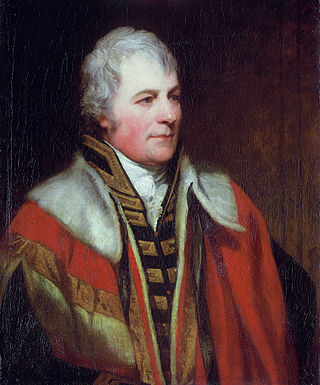
Admiral William Carnegie, 7th Earl of Northesk was a Royal Navy officer who served in the American Revolutionary War and French Revolutionary and Napoleonic Wars. While in command of HMS Monmouth he was caught in the Nore Mutiny of 1797 and was the officer selected to relay the demands of the mutineers to George III. He most notably served as third-in-command of the Mediterranean Fleet at the Battle of Trafalgar in HMS Britannia. He later became Rear-Admiral of the United Kingdom and Commander-in-Chief, Plymouth.
The 2nd North Carolina Regiment was an American infantry unit that was raised for the Continental Army during the American Revolutionary War. In 1776 the regiment helped defend Charleston, South Carolina. Ordered to join George Washington's main army in February 1777, the regiment subsequently fought at Brandywine and Germantown during the Philadelphia Campaign. After most other North Carolina regiments were sent home to recruit, the 1st and 2nd Regiments remained with the main army and fought at Monmouth in June 1778. The regiment was transferred to the Southern Department and was captured by the British army in May 1780 at the Siege of Charleston. Together with the 1st Regiment, the unit was rebuilt and fought capably at Eutaw Springs. The 2nd was furloughed in April 1783 and officially dissolved in November 1783.
Events from the year 1782 in Great Britain. The American Revolutionary War draws to a close.
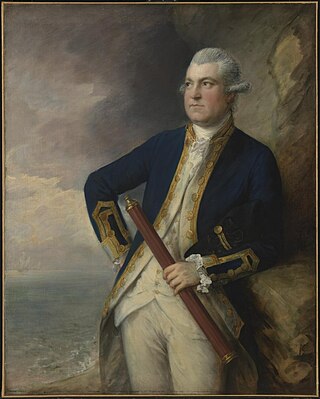
Vice-Admiral Sir Charles Thompson, 1st Baronet was a British Royal Navy officer. After long service in the Seven Years' War, American Revolutionary War and French Revolutionary Wars, he was second in command at the battle of Cape St Vincent. However, his disregard for Sir John Jervis' signal to tack to counter a Spanish attacking move nearly lost the battle, and began an enmity with Jervis that eventually led to Thompson's retirement. From 1796 to 1799 he was also MP for Monmouth.
Admiral John Bazely was an experienced and highly respected officer of the British Royal Navy who served in three wars and saw numerous actions, notably during the American War of Independence. He first gained notice with the capture of the American brig USS Lexington in 1777, following which he was rapidly promoted and by 1779 was a post captain and fought in engagements under Augustus Keppel and George Rodney with some success. He later served in the Channel Fleet under Lord Howe and fought at the Glorious First of June, although his career stagnated during the French Revolutionary Wars and he was unemployed for the final decade of his life, despite his being "regarded with respect and gratitude by his compatriots at large".

Vice-Admiral Thomas Pringle was a Royal Navy officer who served in the American War of Independence and the French Revolutionary and Napoleonic Wars.

Vice-Admiral Sir George Murray KCB was an officer in the Royal Navy who saw service in a wide range of theatres and campaigns. His active naval career spanned the American War of Independence and the French Revolutionary and Napoleonic Wars. Murray served under many of the most notable commanders of his age and participated in several of their greatest victories. He was with Parker and Howe in the West Indies and North America, Johnstone and Hughes in the East Indies, Jervis at Cape St Vincent, Nelson at Copenhagen, and took part in a host of other actions and engagements. Temporarily a captive of the French he was a keen scholar and spent time learning the French language and their naval customs, as well as being a competent surveyor, experience that was to help him in later life. He had a particularly enduring friendship with Nelson, who personally requested his services as his captain of the fleet. It was only chance that prevented Murray from serving as such at Trafalgar. With Murray absent, Nelson declined to appoint a replacement, one biographer reasoning that "none but Murray would do".

Admiral Sir Robert Brice Kingsmill, 1st Baronet was an officer of the Royal Navy who served during the Seven Years' War, the American War of Independence and the French Revolutionary and Napoleonic Wars in a career that spanned nearly 60 years. Kingsmill was a contemporary and close friend of Lord Nelson, and was one of the prominent Royal Navy admirals of his time referred to as "The Conquerors of the Seas", illustrated in Piercy Roberts' 1800 engraving. He served with Rodney in the West Indies, where he was wounded in battle, and with Keppel at the Battle of Ushant. He took the time to embark on a career in politics as a Member of Parliament, giving this up several times to resume his service in the Navy when war broke out. Kingsmill rose to flag rank by the time of the outbreak of war with revolutionary France in 1793. As the naval commander-in-chief on the coast of Ireland, he repelled several attempts by the French to invade Ireland and foment insurrection. Kingsmill died on 23 November 1805 at Sydmonton Court as a baronet and with the rank of Admiral of the Blue.
Events from the year 1778 in the United States.

Rear-Admiral John Leveson-Gower was a Royal Navy officer and politician from the Leveson-Gower family. As a junior officer he saw action at the Battle of Lagos in August 1759 during the Seven Years' War. As captain of HMS Valiant he was present at the Battle of Ushant on 17 July 1778 during the American War of Independence. He went on to be a junior Lord of the Admiralty and then First Naval Lord. He also sat as Member of Parliament for several constituencies.
Events from the year 1778 in Scotland.

HMS Roebuck was a fifth-rate ship of the Royal Navy which served in the American and French Revolutionary Wars. Designed in 1769 by Sir Thomas Slade to operate in the shallower waters of North America, she joined Lord Howe's squadron towards the end of 1775 and took part in operations against New York the following year. She engaged the American gun batteries at Red Hook during the Battle of Long Island in August 1776, and forced a passage up the Hudson River in October. On 25 August 1777, Roebuck escorted troopships to Turkey Point, Maryland, where an army was landed for an assault on Philadelphia. She was again called upon to accompany troopships in December 1779, this time for an attack on Charleston. When the ships-of-the-line, which were too large to enter the harbour, were sent back to New York, Admiral Marriot Arbuthnot made Roebuck his flagship. She was, therefore, at the front of the attack, leading the British squadron across the shoal to engage Fort Moultrie and the American ships beyond.